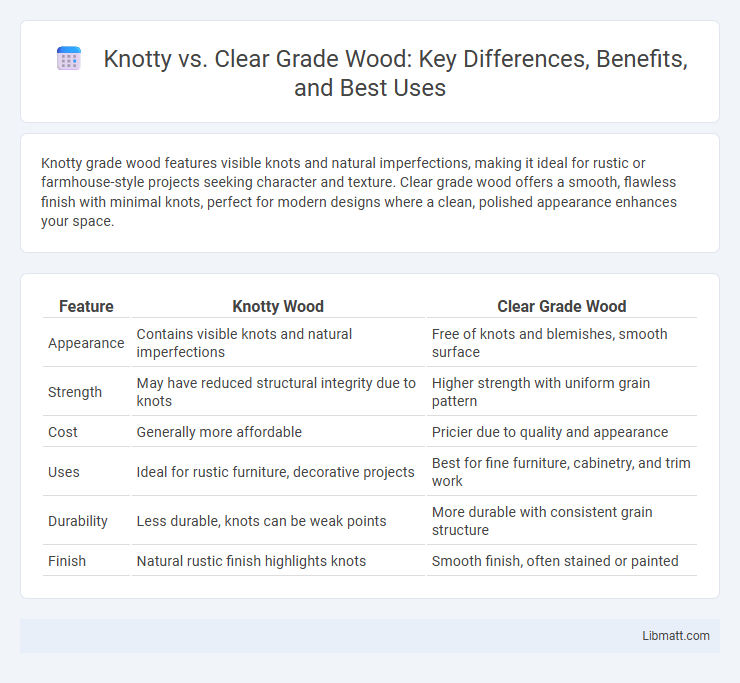Knotty grade wood features visible knots and natural imperfections, making it ideal for rustic or farmhouse-style projects seeking character and texture. Clear grade wood offers a smooth, flawless finish with minimal knots, perfect for modern designs where a clean, polished appearance enhances your space.
Table of Comparison
| Feature | Knotty Wood | Clear Grade Wood |
|---|---|---|
| Appearance | Contains visible knots and natural imperfections | Free of knots and blemishes, smooth surface |
| Strength | May have reduced structural integrity due to knots | Higher strength with uniform grain pattern |
| Cost | Generally more affordable | Pricier due to quality and appearance |
| Uses | Ideal for rustic furniture, decorative projects | Best for fine furniture, cabinetry, and trim work |
| Durability | Less durable, knots can be weak points | More durable with consistent grain structure |
| Finish | Natural rustic finish highlights knots | Smooth finish, often stained or painted |
Understanding Knotty vs Clear Grade Lumber
Knotty grade lumber contains visible knots and natural imperfections, making it ideal for rustic or decorative projects that embrace wood's natural character. Clear grade lumber is free from knots and defects, offering a smooth, uniform appearance suitable for fine woodworking, cabinetry, and furniture where aesthetics and finish quality are crucial. Choosing between knotty and clear grade lumber depends on project requirements, balancing visual style with strength and cost considerations.
Key Differences Between Knotty and Clear Grades
Knotty grade wood contains visible knots and natural imperfections, offering a rustic and authentic appearance, while clear grade wood is free from knots and defects, providing a clean, smooth surface ideal for fine finishing. Knotty grade wood often features varied color tones and textures due to the knots, whereas clear grade wood maintains uniformity and consistent grain patterns. Clear grade is preferred for high-end cabinetry and furniture where aesthetics and smoothness are critical, while knotty grade is commonly used in designs emphasizing natural character and ruggedness.
Aesthetic Appeal: Knotty vs Clear Grade
Clear grade wood offers a smooth, uniform surface free from knots, providing a sleek and polished aesthetic ideal for modern, minimalist designs. Knotty grade wood features natural knots and imperfections that add character and rustic charm, enhancing spaces with a warm, organic feel. Your choice between knotty and clear grade depends on whether you prefer a clean, refined look or a textured, natural appearance.
Structural Properties of Knotty and Clear Lumber
Knotty lumber contains knots and natural imperfections that can reduce its strength and make it less suitable for structural applications requiring high load-bearing capacity. Clear grade lumber, free from knots and defects, exhibits superior structural properties, offering increased stability, uniformity, and higher tensile strength essential for critical construction elements. Engineers often prefer clear lumber in frameworks where maximum performance and durability are paramount.
Cost Comparison: Knotty vs Clear Grade
Knotty wood tends to be more affordable than clear grade due to the abundance of natural knots and imperfections that reduce processing costs. Clear grade wood commands a higher price as it undergoes stricter selection and grading for uniformity, free from knots and defects, making it desirable for high-end projects. Budget-conscious buyers often choose knotty wood for its cost efficiency, while clear grade is preferred where aesthetic quality justifies the premium expense.
Best Uses for Knotty Grade Lumber
Knotty grade lumber is ideal for rustic furniture, decorative paneling, and farmhouse-style interiors where natural wood imperfections enhance visual appeal. Its characteristic knots and unique grain patterns provide a distinctive, textured look perfect for accent walls or cabinetry in casual, warm settings. Your projects benefit from the organic charm of knotty lumber, making it a popular choice for design styles that embrace natural wood character.
Ideal Applications for Clear Grade Lumber
Clear grade lumber, free from knots and defects, is ideal for applications requiring high aesthetic appeal and structural integrity, such as fine cabinetry, furniture, and trim work. Its smooth surface ensures excellent paint or stain finishes, making it perfect for visible interior uses like paneling and molding. Clear grade wood also offers enhanced strength and uniformity, suitable for precision woodworking projects where consistency is critical.
Durability and Maintenance: Knotty vs Clear
Knotty wood often has natural knots that can create weak points, making it slightly less durable compared to clear grade wood, which is free of knots and offers consistent strength. Clear grade wood requires less maintenance since it is less prone to cracking and warping, while knotty wood may demand more frequent sealing and inspection to prevent damage around the knots. Choosing clear grade for your project ensures longevity and easier upkeep, especially in high-traffic or moisture-prone areas.
Environmental Impact of Knotty and Clear Grades
Knotty wood grade, featuring natural imperfections like knots, often contributes to reduced waste by utilizing parts of the tree that might otherwise be discarded, supporting sustainable forestry practices. Clear grade lumber, characterized by its lack of knots and defects, typically requires more selective harvesting and processing, potentially increasing resource consumption and environmental cost. Choosing knotty grade wood can align with your commitment to eco-friendly building materials by promoting efficient use of forest resources and minimizing environmental impact.
Choosing the Right Lumber: Knotty or Clear?
Selecting the right lumber depends on your project's aesthetic and structural needs, with knotty wood offering rustic charm and natural character, while clear grade provides a smooth, uniform surface ideal for fine finishes. Knotty lumber contains visible knots that enhance visual interest but may affect strength, whereas clear lumber is free from knots, ensuring higher durability and ease of staining or painting. Your choice should balance the desired look with performance requirements to achieve optimal results.
Knotty vs clear grade Infographic

 libmatt.com
libmatt.com